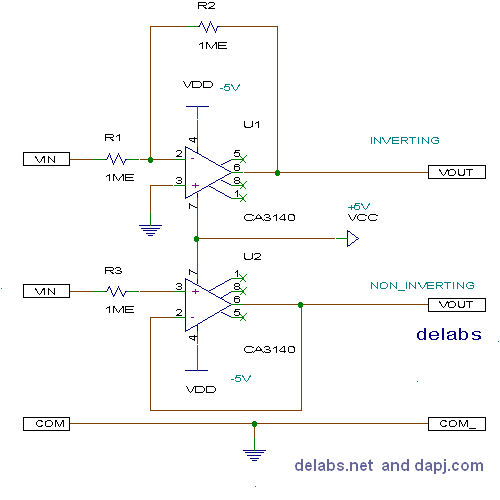Buffer or Unity Gain Op-Amp
If output impedance of a point is a high value then
connecting another circuit at that point will load it
resulting in malfunction or error. Buffers are used as
interface between circuits. Low impedance of an output means
it can source sink lot of current, when you need 2 opamps use
LF353 or TL072 which are dual opamps.
Instrumentation and Automation - 01
A non-inv FET input is the best buffer, for inverting buffer
use high R values Using very high R values like 2.2M or higher
requires a glass epoxy PCB and guard rings around pin 2, 3 to
prevent leakage currents on the PCB reaching the PINs. Also
moisture and dust has to be prevented by using RTV coating or
Varnish. Use 78L05 79L05 for the dual supply required by this
circuit.

Vout = -(Vin) for inverting
Vout = Vin for non-inverting
Interactive Tutorials using Virtual Electronic Components
This is an Interactive Tutor with Virtual Meters and Pots, shows how a Unity Gain Buffer Operational Amplifier works. When no gain is required and you need to match impedance this can be use. Front end amps, Sensor amps. Polarity Inversion in Analog Computing or Signal Conditioning.
Precision Op-Amp Current Source
Slide the Potentiometers just like you would operate a Sliding Control. Drag the Knob on Pot to increase or decrease the resistance. The Resistance is shown is blue letters and dynamically alters value as you slide the pot.
Use the "iframe" part in this Buffer Unity Gain OpAmp xml code
The mV Source is varied by just moving mouse pointer over the two buttons, no clicking. This reduces finger strain and also you have a long lasting mouse. The mV buttons are special, the variation picks up speed if you let the mouse pointer remain on the button. This is Ramp-up and Ramp-down. This enables you to set it faster with just two buttons.
Design Notes - Product Development - 07
Finally you have a DVM a Digital Volt Meter that just Displays the Voltage at any Point, this readout value has to be noted down.
More Opamp Simulations
- Inverting Amplifier - Op-Amp Circuits
- Non-Inverting Amplifier - Op-Amp Circuits
- Differential Amplifier - Op-Amp
Circuits
- 3 Op-Amp Differential Instrumentation Amp
- Buffer or Unity Gain Op-Amp
- Two Op-Amp Differential Amplifier
Back to Analog Op-Amp Circuits
...
...
...
...
...
delabs Technologies
20th Mar 2020
...
The documents, software, tools and links are provided to enhance the ability of an electronics student, hobbyist or professional by sharing information. The information, links etc. should be used by the website visitor, at his or her own risk and responsibility. There may be concept, design and link errors in the pages.
Creative Work, ideas and documents of delabs can be used for Product Design and Development by R&D Engineers, Hobbyists, Students and even firms for creating useful products. These cannot be used for reprint, replication or publishing online or offline.

